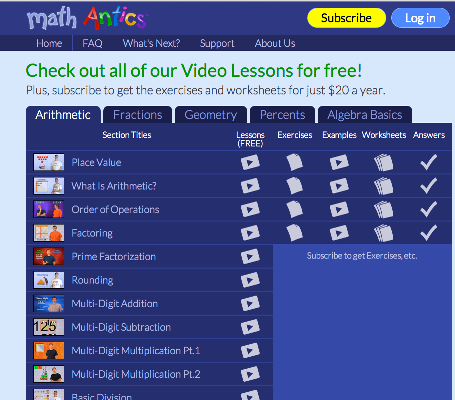- MN ABE Connect
- Archive
- Math Antics
Math Antics
Lindsey Cermak, GED Instructor/CoordinatorLooking for supplemental video material for your math class? Here is a resource that contains straightforward explanations of math concepts and provides plenty of practice exercises. These resources are designed to offer supplemental material and are not meant to be a stand-alone curriculum.
What is Math Antics?
It can be difficult to create a working knowledge of a certain topic with a group of multi-level students. Some students may already have sufficient knowledge of a topic while others need everything spelled out from the beginning. Math Antics is a website that houses several videos on the topics of arithmetic, fractions, geometry, percents, and algebra basics. There are worksheets, exercise explanations, and answer keys that correspond with each video to offer students practice. These video explanations are straightforward and basic enough to provide lower level students a working knowledge of the topics while at the same time make sure higher level students do not have any “holes” in their understanding.
How can I use Math Antics?
 Some of these videos have aided my students in visualization and building an understanding of a given topic. It has also offered a great opportunity for me to try a flipped classroom approach: I assign a video or two for students to watch before class, and then use class time to build upon the concept(s) introduced in the video.
Some of these videos have aided my students in visualization and building an understanding of a given topic. It has also offered a great opportunity for me to try a flipped classroom approach: I assign a video or two for students to watch before class, and then use class time to build upon the concept(s) introduced in the video.
This resource does not contain an exhaustive amount of videos—more videos are being created upon request. While the creators have said that the videos do not align with any particular set of standards to remain “…as universal as possible”, some of the content and exercises certainly align with the CCRS standards. For example, there is a video that explains types of fractions, and how to compare their relative sizes. This video could be used to partly address:
- 3.NF.1 Understand a fraction 1/b as the quantity formed by 1 part when a whole is partitioned into b equal parts; understand a fraction a/b as the quantity formed by a parts of size 1/b
- 3.NF.2 Understand a fraction as a number on the number line; represent fractions on a number line diagram
- 3.NF.3 Explain equivalence of fractions in special cases, and compare fractions by reasoning about their size
However, the corresponding worksheets with this video do not fully address these standards. The first page has students merely name the fractions (not aligned), while the subsequent worksheets ask students to estimate size and compare values (aligned to 3.NF.3). To supplement this lesson, teachers can combine use of the videos with exercises such as this one to directly address the standards (in this case, 3.NF.2).

Once the teacher knows the objective of the lesson, Math Antics can be a great resource to check with for a video. Many (not all) of them offer a clear explanation that is easy for students to understand. I have seen some of my students’ procedural skills with solving one-step equations improve dramatically after watching part 1 and part 2 on solving for the unknown in one-step equations. I did supplement these videos and practice exercises with classroom explanation and additional worksheets from textbooks, but the videos established a solid foundation for the comprehension to happen. I have taught lessons on solving for the unknown in the past. With such an abstract concept, it can be hard for students to grasp the material and make sense out of it. However, I noticed a significant difference in my students’ understanding of and comfort with one-variable equations after viewing these videos.
Is this a FREE resource?
All of the videos on this website are free, but a subscription ($20/year) is required to access all of the exercises. With the subscription comes a teacher license to print materials. Teachers can certainly just access the free materials, and then create or find other practice exercises.
Where can I find this and other similar resources?
In the ATLAS Numeracy Resource Library you will find these among many, many other great resources for teaching math (and we’re still adding more!). Whether you are looking for an instructional idea for tomorrow’s lesson, a resource to help you better understand certain math content, or information about the math content standards, you will find a wealth of helpful resources that are worth a look.
In the Numbers & Operations section of the Numeracy Resources library, you will find the following Math Antics entries:

Newsletter Signup
Get MN ABE Connect—the official source for ABE events, activities, and resources!
Sign UpArticle Categories
- ABE Foundations/Staff Onboarding
- ACES/Transitions
- Adult Career Pathways
- Assessment
- CCR Standards
- Citizenship
- COVID-19
- Cultural Competency
- Digital Literacy/Northstar
- Disabilities
- Distance Learning/Education
- ELA
- Equity/Inclusion
- ESL
- HSE/Adult Diploma
- Listening
- Math/Numeracy
- Mental Health
- Minnesota ABE
- One-Room Schoolhouse/Multilevel
- Professional Development
- Program Management
- Reading
- Remote Instruction
- Science
- Social Studies
- Speaking/Conversation
- Support Services
- Teaching Strategies
- Technology
- Uncategorized
- Volunteers/Tutors
- Writing